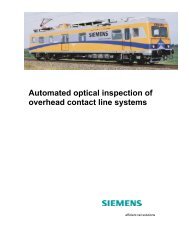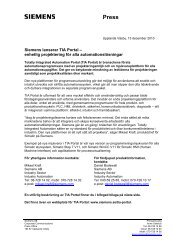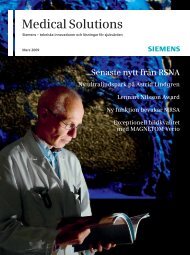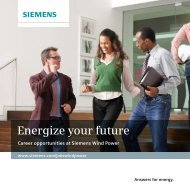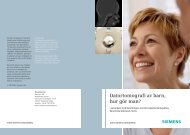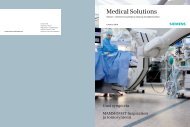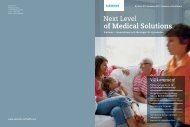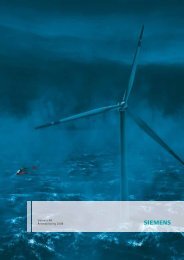European Green City Index - Siemens
European Green City Index - Siemens
European Green City Index - Siemens
You also want an ePaper? Increase the reach of your titles
YUMPU automatically turns print PDFs into web optimized ePapers that Google loves.
<strong>European</strong> <strong>Green</strong> <strong>City</strong> <strong>Index</strong> | Lessons from the leaders<br />
Waste<br />
Amsterdam and Zurich come in first and second<br />
respectively in the waste category of<br />
the index (which also encompasses land use).<br />
The reasons for their success in waste management,<br />
however, differ greatly and show how communities<br />
can take various paths to the same end.<br />
Zurich’s strength in recent decades has been<br />
waste reduction. As early as 1985, the city decided<br />
that it could not continue to incinerate all the<br />
garbage that it was producing. It chose to place<br />
the cost of dealing with waste on producers.<br />
Since the early 1990s residents have had to use<br />
specially purchased “Zueri-sacks” to dispose of<br />
all rubbish or face substantial fines. The sacks<br />
are sold in local stores, with costs varying on the<br />
size of the sack, giving a significant incentive to<br />
throw out as little as possible and to use one of<br />
the many free collection points across the city<br />
for recyclable materials. Within three years,<br />
waste production in the city dropped by 24%.<br />
Now Zurich creates only 406 kg of garbage per<br />
resident, well below the index average of 511 kg<br />
and putting the city in fourth place among those<br />
in the index. At the same time, it recycles 34% of<br />
waste, the fourth best figure in that category.<br />
Despite various public information campaigns,<br />
Amsterdam does only modestly well at<br />
waste reduction: its actual levels of waste production<br />
per resident, at 487 kg, is below average,<br />
but it still ranks 17th out of the 30 cities in<br />
the index. Instead, the city’s strength is in what it<br />
does with the garbage. As Carolien Gehrels, an<br />
Amsterdam <strong>City</strong> Council Alderwoman whose areas<br />
of responsibility include waste management,<br />
explains: “We always say ‘garbage is gold.’ Waste<br />
is not a problem but a valuable raw material.”<br />
This begins with recycling: the city recycles 43%<br />
of all its waste, second only to Helsinki, and Ms<br />
Gehrels notes that for household waste the<br />
overall Dutch and Amsterdam figure is 64%. She<br />
sees three reasons for success here. One is the<br />
city’s ongoing efforts to raise public awareness.<br />
A second is tradition: given how long it takes to<br />
reform people’s habits, Ms Gehrels believes the<br />
fact that the Dutch have been separating their<br />
garbage already for decades is important for<br />
achieving consistently high levels of participation.<br />
A third is ensuring that sorting and recycling<br />
is very easy, with collection points on nearly<br />
every street corner.<br />
Other cities have similar, if less successful,<br />
recycling efforts. But what really sets Amsterdam<br />
apart is its use of non-recyclable waste. The<br />
city has been incinerating waste for over 90<br />
years, and Amsterdam’s Waste and Energy Company<br />
(AEB) has become a leader in waste-toenergy<br />
technology. Its newly built power plant,<br />
with some 30 process innovations developed inhouse,<br />
has the world’s highest energy efficiency<br />
for a waste-powered facility, at 30%. The company<br />
produces enough energy to power more than<br />
three-quarters of Amsterdam’s households, and<br />
provide 300,000 gigajoules of district heat,<br />
reducing CO2 production in the city by 470 kilotonnes.<br />
The resultant ash is richer in minerals<br />
than most mine ore, and AEB is able to profitably<br />
recover various metals, including iron and gold,<br />
and sell most of the rest as raw material for<br />
buildings. Only 1% of the 1.4 million tonnes of<br />
waste entering the system goes to landfill. The<br />
city eventually hopes to go further, and move<br />
from a waste management approach to sustainable<br />
material and energy cycles. Ms Gehrels says<br />
that it is important for AEB to be at the cutting<br />
edge of technology to give it a competitive<br />
advantage. However, she argues that what is<br />
really needed now to allow such development to<br />
flourish is a level playing field in Europe, with an<br />
open market and a common <strong>European</strong> standard<br />
for energy from waste. AEB, she notes, makes a<br />
good, profitable return using its technology and<br />
approach (despite high upfront investment<br />
costs), yet it is not allowed to compete for processing<br />
waste generated in Germany, for example,<br />
while German companies can take Dutch<br />
waste. Everyone needs to play by the same rules<br />
to have an “honest chance that your investment<br />
will have the right return.”<br />
Amsterdam and Zurich are not polar opposites:<br />
the former is increasing its use of wastepowered<br />
district heating, and the latter still sees<br />
waste prevention as the most environmentally<br />
friendly approach to the issue. Nevertheless, the<br />
different emphasis by each may be no accident.<br />
Ms Gehrels notes that scale is important in getting<br />
energy from waste, although she adds that<br />
smaller municipalities can work with others<br />
within the same region. It is likely to be easier for<br />
smaller cities to make an impact by focusing on<br />
reduction. Nevertheless, the two examples do<br />
show that treating waste as a problem and as a<br />
resource both have their place in urban environmental<br />
management.<br />
Ideas from<br />
other cities<br />
The recently established London Waste and<br />
Recycling Board has created a “dating<br />
agency” to attract companies interested in<br />
using different kinds of waste for either fuel<br />
or recycling.<br />
Ljubljana introduced a lottery in late 2008<br />
to encourage recycling. A household or office<br />
recycling bin is randomly selected to win<br />
money—if it contains the correct type of<br />
waste.<br />
Vienna has created the Vienna Repair Network,<br />
a group of over 50 repair shops which<br />
people are encouraged to visit rather than<br />
throwing away broken goods. “Frequent user”<br />
cards give customers a discount on every<br />
fourth item repaired.<br />
28 29




